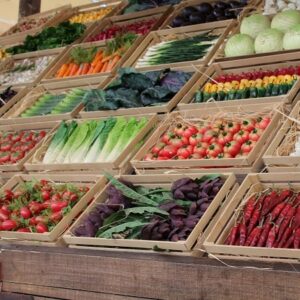The end of summer is upon us and we start to wonder how do we keep our golden glow? It’s amazing how much healthier we feel when we have some colour to our skin. We’ve all been told how bad tanning beds are for us, so that’s not a good idea. Luckily there’s a surprisingly healthy answer – eat more vegetables!
“What!” I hear you say, “how can veg give me a golden tan?”
Scientists now say that eating more fruit and vegetables really does lead to a golden skin tone, which signals good health to potential mates and increases your attractiveness (ref: The Telegraph). This is because skin can become coloured through a process called ‘carotenoid colouration’, when eating a diet rich in carotenoids. Whereas tanning in the sun makes the skin go brown, through a process called ‘melanin colouration’.
British scientists asked volunteers to rate how attractive they found faces digitally enhanced to show pigmentation caused by ‘carotenoid coloration’ from eating fruit and vegetables, or ‘melanin coloration’ caused by tanning in the sun.
In the study (ref: The Quarterly Journal of Experimental Psychology) more than 76% said the golden glow from eating lots of vegetables was more attractive than the brown glow achieved through a sun tan!
What are carotenoids? Carotenoids are a class of more than 600 naturally occurring pigments synthesized by plants. These richly coloured molecules are the sources of the yellow, orange and red colours of many plants. Fruit and vegetables provide most of the carotenoids in the human diet.
So which vegetables are the best to eat to get this healthy glow? Red, orange and yellow fruit and veg are rich in carotenoids, and include sweet potato, carrots, red peppers and tomatoes. But green vegetables are also great sources, it’s just that the ‘green’ hides the other colours. Top sources are broccoli and dark leafy greens like chard, spinach, cabbage and kale (ref: 10 foods high in beta-carotene).
The best known carotenoid is beta-carotene and is the reason carrots, pumpkins & sweet potatoes are orange. Lycopene is the red in fruits and veg such as tomatoes and watermelon, lutein is found in dark green vegetables such as broccoli, cabbage, Swiss chard & spinach and canthaxanthin is found in yellow vegetables (and egg yolks).
How much do I need to eat? A previous study found that eating two extra portions of fruit and vegetables a day led to a noticeable change in skin colour in just six weeks… (ref: Daily Mail).
Of course there are other advantages to eating more of these fruit and vegetables, such as increased vitamin E, vitamin A and anti-oxidants (Ref: Living Strong – Can You Change Skin Tone with Food?). Carotenoids are also thought to be associated with reduced risk of several chronic health disorders including some forms of cancer, heart disease and eye degeneration (ref: International Carotenoid Society). With such a range of health benefits, maybe the golden skin tone is our in-built sign to show general good health?
And an easy way to increase your daily intake is a Green Smoothie every morning. Here’s my previous blog about other benefits – Smooth(ie) Operator.
So even if your reason for eating more fruit & vegetables is pure vanity to keep your golden glow, you’ll reap a lot of other health benefits too!
Caution:
The human body converts beta-carotene into vitamin A. This mechanism is automatically regulated by the individual’s vitamin A status – if the body has enough vitamin A, the conversion of beta-carotene decreases. Therefore, beta-carotene consumed from natural sources is a very safe source of vitamin A and high intakes will not lead to toxic levels of vitamin A (ref: Wikipedia – Beta-Carotene).
However vitamin A is unsafe when taken by mouth in high doses, especially as a supplement, as vitamin A is not water soluble and becomes stored in the body’s tissue (mostly the liver) causing a potentially dangerous condition called hypervitaminosis A (ref: Wikipedia – Hypervitaminosis A).


